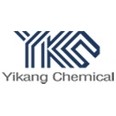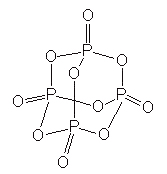Phosphorus Pentoxide
IMDG Code: GB8.1 Class 81063. Base iron: grade-A inorganic acid corrosive goods, 91034, UN NO.: 1807.
CAS NO.: 1314-56-3
UN NO.: 1807
HS code: 28091000
Molecular Formula: P2O5
Molecular Weight: 141.94
Structural formula: 
Uses: As raw material for phosphorus oxychloride and metaphosphoric acid; for acrylic ester, surfactants, dehydrating agents, driers, anti-static agent, refining of drugs and sugars, analytical reagent.
Properties: It is usually white, highly deliquescent crystalline powder. Density: 0.9g/cm3, sublime at 300°C. M.P.: 580-585°C. Vapor tension: 133.3Pa (384°C). It will become vitreous body when heated at high temperature under pressurization. It can easily absorb moisture in the air; will release white fume when dissolving in the water.
Risk Characteristics: Non-combustible. Will react violently with exposure to water, wood, cotton or grass and can burn. Can generate large amount of smog and release heat in water; slightly corrosive to most metals. Locally highly irritating to eyes, skin, mucous membrane and respiratory system.
Emergency Measures & Fire Fighting: Firefighters must wear full-bodyarmour; fight fire with sand and dry powder instead of water. First aid: Sufferers inhaled steam must be evacuated from polluting area, put down to have rest and keep warm. If eyes are polluted, wash eyes with water for 15 min. above, and then see the doctor. For skin contact, wash skin with water first, and then smear with magnesia-glycerine ointment. If burnt, see the doctor. For oral taking, wash the mouth, drink water and milk of magnesia, and then see the doctor.
Storage: Corrosive. Packing: Class (II). Stored in cool, dry and droughty warehouse. No mixing with inflammables and alkali. Handle with care. Containers must be sealed tightly. Protect from rain. Accidental release measures: Wear masks and gloves, mix sodium bicarbonate or mixture of low alkali and lime hydrate into mud, and then put it gradually into water, neutralize and dilute and it into waste water which is put into the waste-water system.
Shelf Life: 30 days from May to September; 60 days from October to April; 12 months in tightly sealed drum.
Specification & Quality Index:
Item | Value |
Grade I | Grade II | Grade III |
Assay(P2O5)% | ≥99% | ≥99% | ≥98.5% |
Active R value | >2 | >1.7 | >1.2 |
Reducing substances(P2O3)% | <0.005% | <0.008% | <0.01% |
Clarity test | Qualified | Qualified | Qualified |
Insol. in water % | <0.01% | <0.01% | <0.02% |
Total Nitrogen (N)% | ≤0.001% | ≤0.002% | ≤0.01% |
Heavy meta (Pb)% | ≤0.001% | ≤0.002% | ≤0.01% |
Iron (Fe)% | ≤0.001% | ≤0.002% | ≤0.01% |
Arsenic (As)% | ≤0.005% | ≤0.008% | ≤0.01% |
Phosphorus pentoxide is a kind of phosphorus oxide formed by white phosphorus, yellow phosphorus or red phosphorus burning in dry air. It is white soft powder or colorless monoclinic crystal at room temperature, and is easy to deliquescence. Phosphorus pentoxide is a common raw material and reagent in the chemical industry. It is widely used in medicine, coating additives, printing and dyeing additives, antistatic agents, chemical industry and other industries. It is mainly used in the manufacture of high-purity phosphoric acid, gas and liquid desiccants, organic synthetic dehydrating agents, and the preparation of organic phosphoric acid.

















